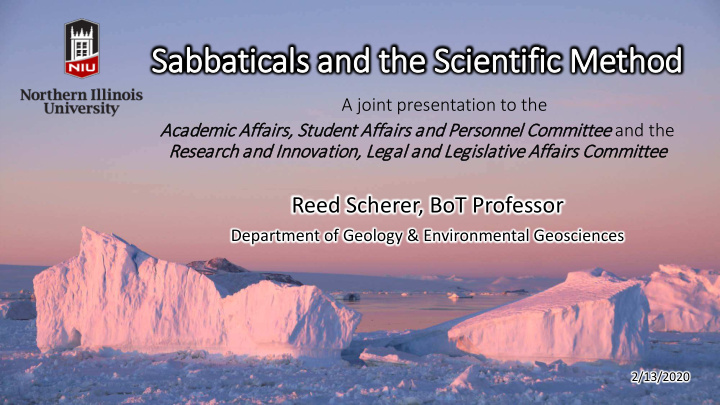



Sabbati ticals a s and t the e Scienti tifi fic M Meth thod A joint presentation to the Academic A Affairs, S Student A Affairs a and P Personnel C Commi mittee and the Research and I Innovatio ion, Le Legal a and Le Legis isla lativ ive A Aff ffair irs C Commit ittee Reed Scherer, BoT Professor Department of Geology & Environmental Geosciences 2/13/2020
My Sabbatical, Fall 2016 • NSF-funded WISSARD Project (2009-2015) • Drilling through the West Antarctic Ice Sheet to study ice sheet stability and history • Relevant to society because knowing the history of ice sheet changes provides key constraints for models that forecast future behavior in a rapidly warming, CO 2 -enhanced world *
My Sabbatical, Fall 2016 • Among the many discoveries, our research showed a very surprising and controversial finding based on analysis of subglacial sediment cores • We then broadened our analyses to include subglacial sediments we’d recovered years ago *
My Sabbatical, Fall 2016 • Our chief finding: • Following the end of the last Ice Age, ~9,000 years ago, the West Antarctic Ice Sheet retreated much faster and much further than previously known • Retreat then halted and the ice sheet regrew to its current configuration, suggesting some previously unknown resilience
My Sabbatical, Fall 2016 • We knew that publishing our findings in the peer-reviewed literature was going to be difficult - the scientific community would be resistant • The peer-review process often requires convincing skeptical colleagues (often our competitors for research funding) to change their understanding • For maximum impact we strive to publish in the most competitive journals • Nature Magazine is the highest ranked scientific journal, accepting only 7.7% of submitted research papers (following a very long vetting process).
My Sabbatical, Fall 2016 • A break from teaching was needed to allow me to focus on the difficult process of writing the manuscript • (note that colleagues at most large research universities have lower teaching loads) • For my 2016 sabbatical I contacted a colleague at Lamont-Doherty Earth Observatory (LDEO), Columbia University, NY and was offered a formal invitation to be Visiting Senior Scientist • A talk I gave at Columbia on WISSARD research turned into a game-changer!
My Sabbatical, Fall 2016 • Joining forces with my new colleagues resulted in a paradigm-changing paper in Nature ( published June, 2018) • NIU co-authors include Profs. Ross Powell & Nathan Stansell, Ph.D. Candidate Jason Coenen, and NIU alumni Slawek Tulaczyk • This paper is ranked in the top 1% of scientific research papers in terms of impact (Altimetric score of 263).
Student Success • This is only one of a number of prominent WISSARD Project papers, several led by graduate students • Most recently, Coenen et al., 2019 (just out in print this week)
Student Success • Jason can certainly attest to the fact that publishing peer-reviewed research papers is a painful, even gut-wrenching process • It requires extraordinary levels of patience, perseverance and the development of a very thick skin! This is similarly the case with obtaining research grants. • The chief reward is the respect and esteem of colleagues around the world. • This extends to your institution!
During the sabbatical, I also: • Gave talks at 5 different universities • Attended and spoke at 2 research conferences • Submitted (and was awarded) a $10,000 research grant from the Columbia University Climate Research Foundation • Used to support NIU undergraduate student research • Developed new lines of research and new collaborations • Held regular Skype meetings with my graduate and undergraduate students • Had numerous media contacts
Media contacts During the 2016 sabbatical I was interviewed by numerous US and • international print and broadcast media regarding my research findings, including the Washington Post and Popular Science , with a potential reach of 60 million readers, not counting Twitter and Facebook hits Media from the 2018 Nature paper was cited by 40 major news outlets • with a reach of 215 million readers, not including Twitter or Facebook Advertising Value Equivalency (AVE) of $2M •
Typical al t timeline f for a a scientific r resear arch p project: 5 5-8 y years rs • Cultivate an idea & mature a hypothesis into a viable research proposal: 1-2+ years • Prepare and submit the research proposal: 3-4 months • Continue this or other research while waiting for proposal results: 1 year • If not funded on first go (likely), revise & resubmit, wait for result: 1 year • Once funded, perform research: 2-4+ years • Prepare manuscript for publication based on new results 1-2 years • Submit, wait for reviews, revise & resubmit (repeat as needed): 2± years So Somewhat an analogous t to a a smal all s star art-up b bus usiness, f from i ide dea t a to profit itib ibilit ility
Sabbatical leaves are a critical component of all research universities • They enhance the profile of the home institution • They offer important professional development opportunities for the faculty • Increase likelihood of future grant funding • Inform and revitalize pedagogy • Can offer critical connections, networking and career opportunities for our students (e.g., graduate programs, research collaborations & jobs) • All of which pay dividends in enhancing NIU’s profile, grant dollars and student career success! • THANK YOU
Recommend
More recommend